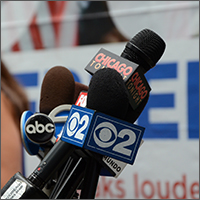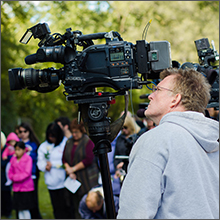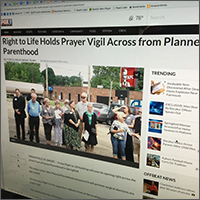You can make impact of your pro-life activism go farther by earning coverage by the local media. Abortion is a hot-button issue that’s frequently in the news. If you present your story in a compelling way, reporters will often want to cover it—if you can get that story in front of them. Use these guidelines to increase your chances of earning media coverage.
- First, understand the media
- Build your media list
- Send out a press release
- Work with media at your event
- Follow up on media coverage
- Don’t be discouraged by a lack of coverage
First, understand the media
Earning media attention for your pro-life events starts with understanding the media and familiarizing yourself with all the media outlets in your area. For many of us, that means overcoming skepticism about the media, which so often appears to have a pro-abortion bias.
Start by reading the Ten Commandments of Media Relations [PDF] by Tom Ciesielka of TC Public Relations, a Chicago firm that Pro-Life Action League has worked with closely. These rules will help you get the best cooperation from the media you can by understanding what attitudes and actions will help get your story told.
In a nutshell, reporters are generally far more interested in telling a good story than in grinding an ideological axe. Giving reporters and editors the benefit of the doubt will serve your mission.
Build your media list

Start with the media outlets you know, like local TV and radio stations. Conservative or religious outlets will naturally have an interest, but don’t limit yourself to those. Look for contact email addresses for these outlets on their websites, and be sure to take down phone numbers as well.
MondoTimes.com is a directory of local media outlets that you can check for more outlets in your area and purchase contact information if you can’t find it on your own. Also look for “hyperlocal” news websites like Patch.com in your area.
You can also simply Google search for “local news media in” and the name of your city or area to find outlets near you. Outlets usually have an email address for tips or press releases listed on their website.
You can also increase the chances that your press release will being seen by someone who wants to cover it by personalizing your outreach. Search for stories on abortion in your area to find out which reporters have already written about abortion, religion or activism on other issues. These reporters will have the greatest interest in your pro-life story, so you should reach out to such reporters directly.
Send out a press release

Be sure to include all the pertinent details about your event — the “5 Ws” of who, what, where, when and why. Reporters can also be drawn in by a list of the “visuals” of your event — that is, what they’ll see and what their photographer can take pictures of. That means things like a picket line or people holding signs, a diverse group of volunteers, striking visuals like a memorial with flowers, well-known speakers, or images of abortion victims.
Along with all the main details about your protest, include a statement in quotations marks that succinctly explains your goals for the event, and attributable that quote to a specific person, either you or someone on your team who will also be willing to talk to any reporters who turn out.
In general, restrict any “editorial” comments — subjective opinions, criticisms of the opposition, etc. — to the quotations in your press release. The main body of the release should have a factual, objective tone.
Send out your press release to all of your local media contacts twice. Send it the first time five days before your event, and then send it again the day before the event.
Below are some sample press releases from past Pro-Life Action League events to get an idea of both the style and tone you should try to strike in your release.
- Press release for a prayer vigil at Planned Parenthood
- Press release for a Face the Truth Tour (display of abortion victim photos)
- Press release for a protest of a Planned Parenthood fundraiser
When you’re working with the Pro-Life Action League on a nationwide event, our team will typically provide a press release template for you, often with sample quotes you can use or modify.
Work with media at your event

The media liaison should have copies of your press release to give to the media, and have also the basic “talking points” of your message down cold. Be sure to stick to the message you want to get out to the media. If their questions aren’t getting to it, make your message come through in your answers to their questions.
Again, be careful to set skepticism aside: don’t assume reporters are hostile. If they’ve already come to cover your event, they’re genuinely interested in the story you have to tell! Be grateful for their presence, welcome them, and stick to your talking points.
Follow up on media coverage
Keep track of any media coverage that you earn for your event. To find coverage, search on Google News for keywords related to your event. A search like this may reveal news outlets you were unaware of, like “hyperlocal” news sites.
Don’t assume that because you didn’t see a media reporter or cameraman that you didn’t get coverage. Sometimes media outlets will write up a story on an event using only the press release you provided.
Maintain a list of links to all the media stories that you find. To help keep your list organized, record both the link to the story and the headline of the story (as well as the date). Also take note of the reporter’s name for future reference: here’s someone who has demonstrated interest in your mission and now has a stake in keeping up with your future activities.
It’s also a good idea to email any reporter who covered your event, especially if they came out personally. Even if there were things in the story you were unhappy with, thanking them for the coverage is still a good idea. If there is a particularly glaring error in the story, you can respectfully request a correction.
Following up on media coverage also includes sending a short follow-up report on your event to all the media you contacted in the first place. Include a short description of the event and a couple of good photos.
Finally, share links to news coverage on your website or social media, and clip out any hard copies from the local newspaper and save them in a safe place. And please let us know about your media coverage so we can share it, too!
Don’t be discouraged by a lack of coverage
You need to know going in that it is difficult to earn media coverage, especially if you live in a larger city. Despite your best efforts, you may not get any coverage.
Don’t be discouraged! Your efforts trying to earn media coverage for one pro-life event may pay off in the future, as you grow more familiar with media outreach, and reporters and editors become more familiar with your work.
Have faith that your efforts will eventually pay off. Meanwhile, keep looking for other media opportunities: outlets you haven’t reached out to yet, bloggers who cover local goings-on, reporters covering related issues. Keep working to earn the media coverage you deserve!
